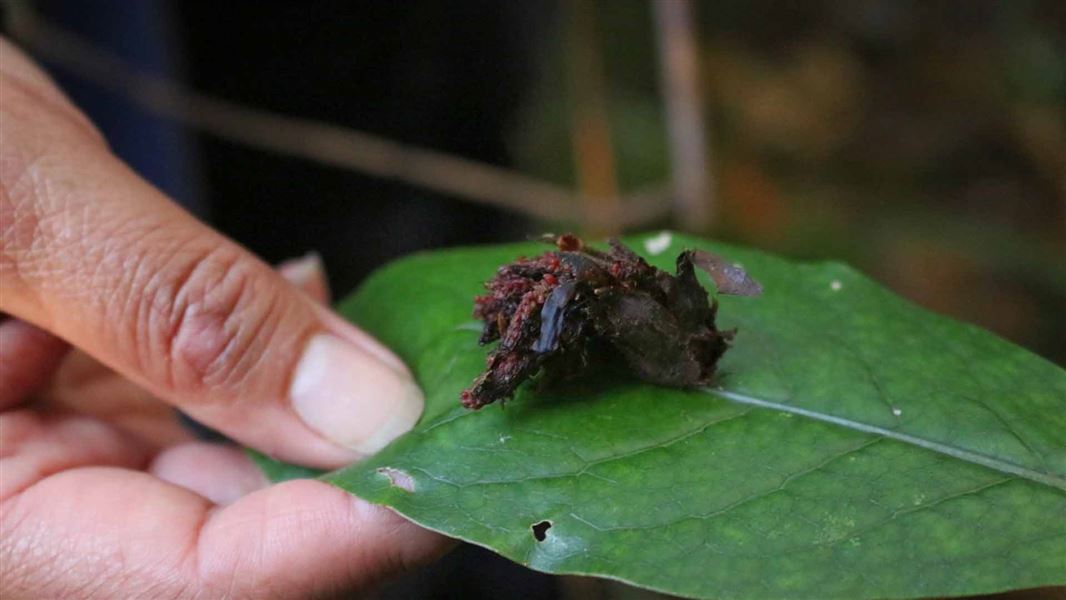Archived content: This media release was accurate on the date of publication.
Date: 15 October 2020
Pua o te Rēinga, te reo Māori for “flower of the underworld”, is an unusual parasitic plant which grows as a tuber attached to the root of a host tree. Specimens of the root connection and the plant itself are sometimes also called woodrose.
The species is currently regarded as being in serious decline, and the Department of Conservation (DOC) has a recovery plan to ensure its survival. Threats include pest animals such as possums and pigs, habitat loss and it being dug up by people. The plant also relies on native bats and some birds for its pollination and seed distribution so threats to these species have a knock-on impact on dactylanthus.
DOC’s Avi Holzapfel has provided technical advice to the translocation project and says the species was widespread in the past, with populations going through a natural, localised boom-and-bust cycle over perhaps a century.
“Even with good seed set, seed distribution to new sites appears to be limited today – whether this is due to the lack of a long-range seed disperser is not known,” Mr Holzapfel says.
“Translocating seed to suitable areas re-establishes the species in places where it would previously have occurred and allows it to take its place in the forest ecosystem as a provider of nectar for ground-dwelling animals and insects.”
A previous seeding trial at Pureora has shown this can be achieved successfully.
A group representing Wellington’s iwi, along with Wellington City Council and ZEALANDIA staff arrived this week at Pureora to collect the seed of Pua o te Rēinga/dactylanthus for the translocation.
Experts at Otari-Wilton’s Bush have been working to bring this special plant back to Wellington for about two years. Otari is the only public botanic garden in New Zealand dedicated solely to native plants.
Representatives of all six Greater Wellington region iwi attended the translocation of the seeds. This is the first time all iwi will be collaborating on a single translocation, says ZEALANDIA’s Bicultural Engagement Lead Ranger, Terese McLeod.
“Our work to return Pua o te Rēinga is bringing about an historic first – where iwi across the Greater Wellington region; Rangitāne, Ngāti Kahungunu, Taranaki Whānui, Ngāti Toa Rangatira, Te Āti Awa ki Whakarongotai and Raukawa are collaborating for the survival and advocacy of this rare and declining species.
Otari-Wilton’s Bush and ZEALANDIA provide habitat which have no or few mammalian predators which will help these populations to establish in Wellington.
“While ZEALANDIA will not be able to rely on bats for pollination, we will be able to explore the relationship this plant has with other native species. For example, it will likely be very appealing to the nectar-loving birds in the sanctuary, and we may even discover they have a role in pollination,” says Dr Danielle Shanahan, Director of ZEALANDIA’s Centre for People and Nature.
Wellington City Council’s Conservation and Science Advisor Karin van der Walt says her team has been researching how the plant germinates, its seed characteristics and its dormancy patterns, all of which have helped them to better understand the plant.
“The translocation of dactylanthus into Wellington provides another important aspect to aid in its conservation while research into seed conservation continues. Germination efforts have been unsuccessful to date, but this has highlighted the importance of planting seed into the wild,” she says.
Contact
For media enquiries contact:
Email: media@doc.govt.nz
